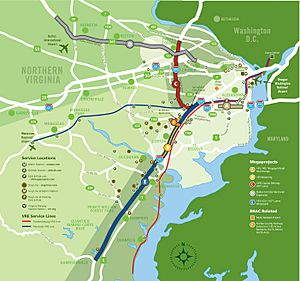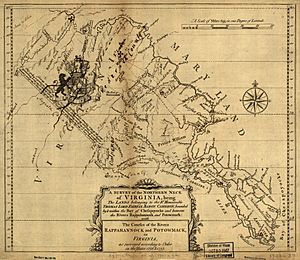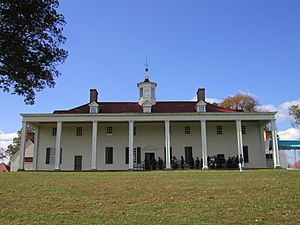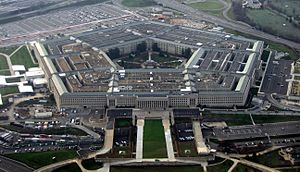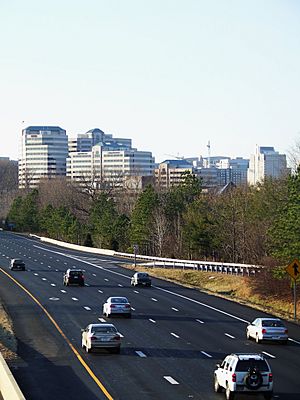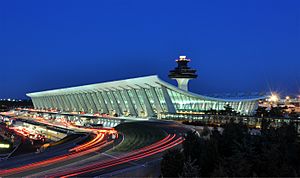Northern Virginia facts for kids
Quick facts for kids
Northern Virginia
|
|
|---|---|
|
Region
|
|
|
Clockwise from the top left: Tysons station entrance on the Metro Silver Line, The Pentagon, Reston and the Dulles Toll Road, Old Town Alexandria, Mount Vernon
|
|
| Nickname(s):
NOVA, NoVA, Nova
|
|
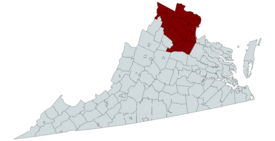
The counties of Virginia that form part of the Washington–Baltimore combined statistical area
|
|
| Country | |
| State | |
| Counties and independent cities | Alexandria, Arlington County, Clarke County, Culpeper County, Fairfax, Fairfax County, Falls Church, Fauquier County, Frederick County, Fredericksburg, Loudoun County, Manassas, Manassas Park, Orange County, Prince William County, Rappahannock County, Spotsylvania County, Stafford County, Warren County, Winchester |
| Largest city | Alexandria |
| Area | |
| • Land | 11,425.6 km2 (4,411.45 sq mi) |
| 13 counties and 7 independent cities in Virginia within the Washington Metropolitan Statistical Area or Washington-Baltimore Combined Statistical Area | |
| Population
(2023)
|
3,257,133 |
| • Density | 285.07/km2 (738.34/sq mi) |
| Demonym(s) | Northern Virginian |
Northern Virginia, locally referred to as NOVA or NoVA, comprises several counties and independent cities in the Commonwealth of Virginia in the United States. The region radiates westward and southward from Washington, D.C., the nation's capital, and has a population of 3,257,133 people as of 2023 U.S. Census Bureau estimates, representing over a third of the state's total population. It is the most populous region in both Virginia and the regional Washington metropolitan area.
Communities in the region form the Virginia portion of the Washington metropolitan area and the larger Washington–Baltimore metropolitan area. Northern Virginia has a significantly larger job base than either Washington, D.C. or the Maryland portion of its suburbs, and is the highest-income region of Virginia, with several of the highest-income counties in the nation, including three of the ten highest counties for median household income, according to the 2019 American Community Survey.
Northern Virginia's transportation infrastructure includes two major airports, Ronald Reagan Washington National and Dulles International Airport, several lines of the Washington Metro subway system, the Virginia Railway Express suburban commuter rail system, transit bus services, bicycle sharing and bicycle lanes and trails, and an extensive network of Interstate highways and expressways.
The Pentagon, the headquarters of the U.S. Department of Defense and the world's second-largest office, is located in Arlington County in Northern Virginia. Northern Virginia also houses the George Bush Center for Intelligence, the headquarters for the Central Intelligence Agency in Langley, the United States Patent and Trademark Office in Alexandria, and several large companies, including several major aerospace manufacturing, consulting firms, and defense industry, which serve it and other components of the U.S. federal government.
Tourist attractions in Northern Virginia include various memorials, museums, and Colonial and Civil War–era sites, including Arlington National Cemetery, Fredericksburg and Spotsylvania National Military Park, Manassas National Battlefield Park, Mount Vernon, the National Museum of the Marine Corps, the National Museum of the United States Army, the Udvar-Hazy Center of the National Air and Space Muuseum, and the United States Marine Corps War Memorial. Other attractions include portions of the Appalachian Trail, Great Falls Park, Old Town Alexandria, Prince William Forest Park, and portions of Shenandoah National Park.
Contents
Etymology
The region is sometimes spelled "northern Virginia", but the U.S. Geological Survey's Correspondence Handbook states that the 'n' in Northern Virginia should be capitalized since it is a place name rather than a direction or general area.
The name "Northern Virginia" does not seem to have been used in the early history of the area. According to Johnston, some early documents and land grants refer to the "Northern Neck of Virginia", a reference to the Northern Neck and describing an area that began at the western shore of the Chesapeake Bay and includes a territory that extended west, including all the land between the Potomac and Rappahannock rivers, with a western boundary called the Fairfax line. The Fairfax line, surveyed in 1746, ran from the first spring of the Potomac River, which remains marked today by the Fairfax Stone, to the first spring of the Rappahannock River, at the head of the Conway River. The Northern Neck was composed of 5,282,000 acres (21,380 km2), and was larger in area than five of the modern U.S. states:
This monument, at the headspring of the Potomac River, marks one of the historic spots of America. Its name is derived from Thomas Lord Fairfax who owned all the land lying between the Potomac and Rappahannock Rivers. The first Fairfax Stone, marked "FX", was set in 1746 by Thomas Lewis, a surveyor employed by Lord Fairfax. This is the base point for the western dividing line between Maryland and West Virginia.
– Fairfax Stone inscription
Early development of the northern portion of Virginia was in the easternmost area of that early land grant, which encompasses the modern counties of Lancaster, Northumberland, Richmond, and Westmoreland. At some point, these eastern counties came to be called separately simply "the Northern Neck", and, for the remaining area west of them, the term was no longer used. By some definitions, King George County is also included in the Northern Neck, which is now considered a separate region from Northern Virginia.
One of the most prominent early mentions of "Northern Virginia" as a title was the naming of the Confederate Army of Northern Virginia during the American Civil War (1861–1865).
Definition
The most common definition of Northern Virginia includes the independent cities and counties on the Virginia side of the Washington-Baltimore-Arlington, DC-MD-VA-WV-PA Combined Statistical Area as defined by the U.S. Office of Management and Budget within the Executive Office of the President of the United States.
Northern Virginia includes five counties, Arlington, Fairfax, Loudoun, Prince William, and Stafford counties, and six independent cities, Alexandria, Fairfax, Falls Church, Fredericksburg, Manassas, and Manassas Park.
History
Colonial period
The Colony of Virginia was settled at Jamestown in 1607. The area now generally regarded as "Northern Virginia" was within a larger area defined by a land grant from King Charles II of England on September 18, 1649, while the monarch was in exile in France during the English Civil War. Eight of his loyal supporters were named, among them Thomas Culpeper.
On February 25, 1673, a new charter was given to Thomas Lord Culpeper and Henry Earl of Arlington. Lord Culpeper was named the Royal Governor of Virginia from 1677 to 1683. Culpeper County was later named for him when it was formed in 1749; however, history does not seem to record him as one of the better of Virginia's colonial governors. Although he became governor of Virginia in July 1677, he did not come to Virginia until 1679, and even then seemed more interested in maintaining his land in the "Northern Neck of Virginia" than governing. He soon returned to England.
In 1682, rioting in the colony forced Culpeper to return. By the time he arrived, however, the riots were already quelled. After apparently misappropriating £9,500 from the treasury of the colony, he returned to England and the King was forced to dismiss him. During this tumultuous time, Culpeper's erratic behavior meant that he had to rely increasingly on his cousin and Virginia agent, Col. Nicholas Spencer. Spencer succeeded Culpeper as acting Governor following Culpeper's departure. Culpeper's descendants allowed Robert "King" Carter and other Virginians to manage the properties.
In 1736, legal claim to the land was finally established by Culpeper's grandson, Thomas Fairfax, 6th Lord Fairfax of Cameron, who became known in the colony as "Lord Fairfax", following a survey authorized by Governor William Gooch. The lands of Lord Fairfax and Northern Virginia were geographically defined as the land between the Rappahannock and Potomac rivers, and were officially called the "Northern Neck". In 1746, a back line was surveyed and established between the headwaters of the Potomac and Rappahannock rivers, defining the west end of the grants. According to documents held by the Handley Regional Library of the Winchester-Frederick County Historical Society, the grant of 5,282,000 acres (21,380 km2) included 22 modern counties, including Northumberland, Lancaster, Westmoreland, Stafford, King George, Prince William, Fairfax, Loudoun, Fauquier, Rappahannock, Culpeper, Madison, Clarke, Warren, Page, Shenandoah, and Frederick counties in Virginia, and Hardy, Hampshire, Morgan, Berkeley, and Jefferson counties in West Virginia.
Lord Fairfax was a lifelong bachelor, and became one of the more well-known persons of the late colonial era. In 1742, the new county formed from Prince William County was named Fairfax County in his honor, one of several locations in Northern Virginia and West Virginia's Eastern Panhandle named after him. Lord Fairfax established his residence at his brother's home at "Belvoir" on the grounds of present-day Fort Belvoir in Fairfax County. He later built a hunting lodge named "Greenway Court", which was located near White Post in Clarke County near the Blue Ridge Mountains, and moved there. Around 1748, he George Washington, who was then 16-years-old. Impressed with Washington's energy and talents, he employed him to survey his lands west of the Blue Ridge Mountains.
Lord Fairfax maintained neutrality as the American Revolutionary War began in 1775. Just a few weeks after the surrender of British Army troops under General Cornwallis at Yorktown, Fairfax died at his home at Greenway Court on December 9, 1781, at the age of 90. He was entombed on the east side of Christ Church in Winchester. While his plans for a large house at Greenway Court never materialized, and his stone lodge is now gone, a small limestone structure he built remains on the site in his honor.
Statehood and Civil War
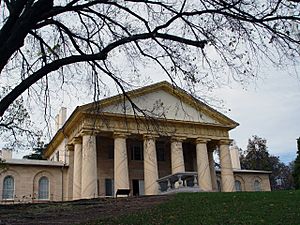
Following the American Revolutionary War, the Thirteen Colonies formed the United States of America, and Continental Army commander and Virginian George Washington became the new nation's first president. Prior to the Revolutionary War, Washington was a surveyor and developer of canals that were used for transportation. He was also a proponent of the bustling port city of Alexandria, located on the Potomac River below the fall line, not far from his plantation at Mount Vernon in Fairfax County.
During much of the colonial era and from 1790 to 1800, the nation's capital was in Philadelphia. In 1800, however, with Washington's guidance and support, the new federal city of present-day Washington, D.C. was laid out and established for the purpose of serving as the national capital. The region straddled the Potomac River and was located on a square of territory ceded to the federal government by Maryland and Virginia. Alexandria, a port city at the time, was on the eastern edge south of the river. On the outskirts on the northern side of the river, was Georgetown, another port city.
As the federal city grew, land in the portion contributed by Maryland proved best suited and adequate for early development. Not really part of the functioning federal city, citizens in Alexandria, who lacked voting input, were frustrated by the laws of the District's government. Slavery also arose as an contentious issue. In 1846, to mitigate these issues and as part of abolishing slave trading in the District, the U.S. Congress passed a bill retroceding to Virginia the area south of the Potomac River, which was then Alexandria County. That area now forms all of present-day Arlington County, which was renamed from Alexandria County in 1922, and a portion of the independent city of Alexandria.
Slavery, states' rights, and economic issues increasingly divided the northern and southern states during the first half of the 19th century, eventually leading to the American Civil War, which lasted from 1861 to 1865. Although Maryland was a slave state, it remained with the Union, while Virginia seceded and joined the newly formed Confederate States of America, whose capital was established at Richmond.
The U.S. Supreme Court has never issued a firm opinion on whether the retrocession of the Virginia portion of the District of Columbia was constitutional. In the 1875 case of Phillips v. Payne, the Supreme Court held that Virginia had de facto jurisdiction over the area returned by Congress in 1847, and dismissed the tax case brought by the plaintiff. The court, however, did not rule on the core constitutional matter of the retrocession. Writing the majority opinion, Justice Noah Swayne stated only that:
The plaintiff in error is estopped from raising the point which he seeks to have decided. He cannot, under the circumstances, vicariously raise a question, nor force upon the parties to the compact an issue which neither of them desires to make.
With barely 100 mi (160 km) separating the two capital cities, Northern Virginia found itself in the center of much of the conflict, which inflicted destruction and bloodshed. The Army of Northern Virginia was the primary army for the Confederate States of America in the east. Owing to the region's proximity to Washington, D.C., and the Potomac River, the armies of both sides frequently occupied and traversed Northern Virginia. As a result, several battles were fought in the area.
Northern Virginia was the operating area of John Singleton Mosby, a Confederate partisan, and several small skirmishes were fought throughout the region between his Rangers and Federal forces occupying Northern Virginia.
Following the end of the Civil War, the conflict remained popular among the region's residents, and many area schools, roads, and parks were named for Confederate generals and statesmen, including Jefferson Davis Highway, Washington-Lee High School, and others.
Virginia split during the American Civil War, as was foreshadowed by the April 17, 1861, Virginia Secession Convention. Fifty counties in the western, mountainous portion of the state were largely opposed to secession in 1861. This region broke away from the Confederacy in 1863 and entered the Union as a new state, West Virginia. Unlike the eastern part of the state, West Virginia did not have fertile lands tilled by slaves and was geographically separated from the state government in Richmond by the Appalachian Mountains. During this process, a provisional government of Virginia was headquartered in Alexandria, which was under Union control during the war. Arlington, Clarke, Fairfax, Frederick, Loudoun, Shenandoah, and Warren Counties voted in favor of Virginia remaining in the Union in 1861, but eventually broke away from the state.
As a result of West Virginia's formation, part of Lord Fairfax's colonial land grant, which defined Northern Virginia, was ceded in the establishment of that state in 1863. Now known as the Eastern Panhandle of West Virginia, the area includes Berkeley County and Jefferson County in West Virginia.
20th century
The Department of Defense's increasing reliance on information technology companies during the Cold War was influential in launching the modern Northern Virginia economy and spurred urban development throughout the region. After end of the Cold War in 1991, prosperity continued in the region as it positioned itself as the "Silicon Valley" of the Eastern United States. The Internet was first commercialized in Northern Virginia, which served as the headquarters of many of the first Internet service providers.
The first major interconnection point of the Internet, MAE-East, was established in the 1990s in Ashburn after Virginia-area network provider operators decided to connect their networks. This infrastructure legacy is ongoing, as data center operators continue to expand near these facilities.
21st century
In early 2001, local Internet company AOL bought Time Warner, the world's largest traditional media company, near the end of the dot-com bubble era. After the Internet bubble burst, however, Northern Virginia office vacancy rates gew from two percent in 2000 to 20 percent in 2002. After 2002, vacancy rates improved, falling below 10 percent as defense spending increased following the September 11 attacks. The subsequent Afghanistan and Iraq wars also contributed to the region's growth, as the federal government increased its contracting with private defense firms.
Regional organizations
Northern Virginia Regional Commission
The Northern Virginia Regional Commission (NVRC) is a regional government that represents a regional council of thirteen member Northern Virginia local governments. These local governments include the counties of Arlington, Fairfax, Loudoun, and Prince William. The local governments include the incorporated cities of Alexandria, Fairfax, Falls Church, Manassas, and Manassas Park. The local governments also include the incorporated towns of Dumfries, Herndon, Leesburg, and Vienna. NVRC's chief roles and functions are providing information, performing professional and technical services for its members, and serving as a mechanism for regional coordination regarding the environment, transportation, affordable housing, community planning, military, and human services. Programs and projects address a wide array of local government interests.
According to Virginia's Regional Cooperation Act, NVRC is a political subdivision. The region is technically referred to as Virginia's planning district #8. The commission was established pursuant to Articles 1 and 2, Chapter 34, of the Acts of the Virginia General Assembly of 1968, subsequently revised and reenacted as the Regional Cooperation Act. Any incorporated county, city, or town in Northern Virginia with a population exceeding 3,500 that adopts NVRC's charter agreement is eligible to become a member of the commission.
Metropolitan Washington Council of Governments
Northern Virginia constitutes a considerable portion of the population and number of jurisdictions that comprise the Metropolitan Washington Council of Governments (MWCOG). Founded in 1957, MWCOG is a regional organization of 22 Washington-area local governments, as well as area members of the Maryland and Virginia state legislatures, the U.S. Senate, and the U.S. House of Representatives. MWCOG provides a forum for discussion and the development of regional responses to issues regarding the environment, transportation, public safety, homeland security, affordable housing, community planning, and economic development.
The National Capital Region Transportation Planning Board, a component of MWCOG, is the federally designated metropolitan planning organization for the metropolitan Washington area, including Northern Virginia.
Demographics
| Historical population | |||
|---|---|---|---|
| Census | Pop. | %± | |
| 1900 | 188,919 | — | |
| 1910 | 194,731 | 3.1% | |
| 1920 | 206,504 | 6.0% | |
| 1930 | 229,205 | 11.0% | |
| 1940 | 298,588 | 30.3% | |
| 1950 | 488,945 | 63.8% | |
| 1960 | 788,162 | 61.2% | |
| 1970 | 1,118,064 | 41.9% | |
| 1980 | 1,357,387 | 21.4% | |
| 1990 | 1,805,091 | 33.0% | |
| 2000 | 2,253,251 | 24.8% | |
| 2010 | 2,794,957 | 24.0% | |
| 2020 | 3,197,076 | 14.4% | |
| 2023 (est.) | 3,257,133 | 16.5% | |
| 1900–2020 | |||
As of April 2020[update] there were 3,197,076 people in Northern Virginia; approximately 37 percent of the state's population.
These population counts include all counties within Virginia that are part of the Washington-Arlington-Alexandria, DC-VA-MD-WV Metropolitan Statistical Area or the Washington-Baltimore-Arlington, DC-MD-VA-WV-PA Combined Statistical Area as defined by the U.S. Office of Management and Budget within the Executive Office of the President of the United States.
Of the 3,159,639 people in Northern Virginia in the 2019 estimates, 2,776,960 lived in "central" counties, or those counties and equivalent entities as delineated by the U.S. Office of Management and Budget as forming part of the urban core of the Washington Metropolitan Statistical Area. These counties include Arlington, Fairfax, Fauquier, Loudoun, Prince William, Stafford and the independent cities of Alexandria, Fairfax, Falls Church, Manassas, Manassas Park and Fredericksburg.
An additional 390,679 people lived in counties of the Washington Metropolitan Statistical Area or the Baltimore-Washington Combined Statistical Area not considered "central." These counties, largely considered exurban or undergoing suburban change, include Clarke, Culpeper, Frederick, Madison, Rappahannock, Spotsylvania, Warren, and the independent city of Winchester.
In addition, there are counties outside of the Washington Metropolitan Area that under more broad definitions are referred to as being part of Northern Virginia. The University of Virginia Weldon Cooper Center for Public Service categorizes King George County as part of Northern Virginia, though the county was removed from the Washington Metropolitan Area in 2003. King George County and Orange County also include areas, such as Lake of the Woods, where the cross-commuting interchange with the Washington Metropolitan Area is high enough to merit inclusion in the Metropolitan Area, although more far-flung parts of these counties still cause the county-wide commuter interchange to fall below the threshold for inclusion in the Washington Metropolitan Area or Washington-Baltimore Combined Statistical Area. The demographic figures above do not include population counts for these two counties.
Racial and ethnic composition
The 2020 U.S. Census resulted in the following racial and ethnic composition for Northern Virginia:
| Jurisdiction | Population (2020 Census) | White alone, not Hispanic or Latino | Hispanic or Latino | Black or African American alone | Asian alone | American Indian and Alaska Native alone | Native Hawaiian and Other Pacific Islander alone | Two or More Races |
| City of Alexandria | 159,467 | 51.9% | 16.7% | 21.8% | 5.9% | 0.2% | 0.0% | 5.3% |
| Arlington County | 238,643 | 61.4% | 15.6% | 9.7% | 11.0% | 0.6% | 0.1% | 3.6% |
| Clarke County | 14,783 | 85.3% | 6.4% | 4.7% | 1.4% | 0.7% | 0.1% | 2.5% |
| Culpeper County | 52,552 | 69.8% | 11.6% | 14.6% | 1.7% | 0.8% | 0.2% | 3.3% |
| City of Fairfax | 24,146 | 56.2% | 17.2% | 4.9% | 17.2% | 0.1% | 0.0% | 5.1% |
| Fairfax County | 1,150,309 | 50.0% | 16.5% | 10.6% | 20.1% | 0.5% | 0.1% | 3.9% |
| City of Falls Church | 14,658 | 71.2% | 10.6% | 4.8% | 10.0% | 0.6% | 0.1% | 4.7% |
| Fauquier County | 72,972 | 79.0% | 9.2% | 7.8% | 1.7% | 0.5% | 0.1% | 2.8% |
| Frederick County | 91,419 | 82.3% | 9.3% | 4.7% | 1.8% | 0.5% | 0.1% | 2.4% |
| City of Fredericksburg | 27,982 | 54.3% | 12.4% | 21.2% | 4.7% | 0.3% | 0.1% | 5.8% |
| Loudoun County | 420,959 | 54.8% | 13.9% | 8.1% | 20.3% | 0.5% | 0.1% | 3.9% |
| Madison County | 13,837 | 84.3% | 3.2% | 9.3% | 0.6% | 0.3% | 0.0% | 2.9% |
| City of Manassas | 42,772 | 39.5% | 38.1% | 15.4% | 6.3% | 1.4% | 0.2% | 3.6% |
| City of Manassas Park | 17,219 | 31.2% | 41.0% | 15.6% | 11.5% | 1.6% | 0.3% | 3.5% |
| Prince William County | 482,204 | 41.5% | 24.5% | 22.2% | 9.4% | 1.1% | 0.2% | 4.7% |
| Rappahannock County | 7,348 | 88.3% | 4.4% | 4.2% | 1.0% | 0.4% | 0.1% | 2.0% |
| Spotsylvania County | 140,032 | 66.6% | 10.7% | 17.5% | 2.8% | 0.5% | 0.2% | 3.6% |
| Stafford County | 156,927 | 59.3% | 14.2% | 20.0% | 3.6% | 0.8% | 0.2% | 4.5% |
| Warren County | 40,727 | 86.0% | 5.3% | 5.0% | 1.3% | 0.6% | 0.1% | 2.6% |
| City of Winchester | 28,120 | 65.7% | 18.3% | 11.3% | 2.7% | 0.9% | 0.1% | 3.6% |
Northern Virginia as a whole is 51.2% White, 17.4% Hispanic, 16.3% Asian, 14.1% Black, and 2.4% Other.
Background
| Demographics in Northern Virginia's five largest jurisdictions | |||
|---|---|---|---|
| Household income | No. VA | U.S. | |
| ($200k+) | 13.6% | 3.7% | |
| $100k+ | 46.1% | 19.0% | |
| $75k-100k | 15.1% | 12.1% | |
| $50k-75k | 16.3% | 18.8% | |
| $25k-50k | 14.2% | 25.6% | |
| $25k or less | 8.4% | 24.5% | |
| Race | No. VA | U.S. | |
| White | 67.2% | 74.1% | |
| Black or African American | 11.6% | 12.4% | |
| Asian | 12.5% | 4.3% | |
| (Hispanic or Latino) | 13.9% | N/A | |
| Some other race | N/A | 6.2% | |
| Two or more races | 2.4% | 2.1% | |
| Educational attainment | No. VA | U.S. | |
| (Graduate/professional) | 25.2% | 9.9% | |
| Bachelor's or higher | 55.5% | 27.0% | |
| Associate's | 5.7% | 7.4% | |
| Some college | 14.8% | 19.5% | |
| High school/equivalent | 15.8% | 30.2% | |
| Less than high school | 8.1% | 15.9% | |
Northern Virginia is home to people from diverse backgrounds, with significant numbers of Korean Americans, Vietnamese Americans, Bangladeshi Americans, Chinese Americans, Filipino Americans, Russian Americans, Arab Americans, Palestinian Americans, Uzbek Americans, Afghan Americans, Ethiopian Americans, Indian Americans, Iranian Americans, Thai Americans, and Pakistani Americans. Annandale, Centreville, Chantilly, and Fairfax City have very large Korean American communities. Falls Church has a large Vietnamese American community, and the region is home to a small Tibetan American community.
There is a sizable Hispanic population, primarily consisting of Salvadorans, Peruvians, Puerto Ricans, Cubans, Bolivians, Mexicans, and Colombians. Arlington is the center of the largest Bolivian community in North America (mostly immigrants from Cochabamba). Many of these immigrants work in transportation-related fields, small businesses, hospitality, vending, gardening, construction, and cleaning.
Of those born in the U.S. and living in Northern Virginia's four largest counties, their place of birth by census region is 60.5 percent from the South, 21.0 percent from the Northeast, 11.5 percent from the Midwest, and 7.0 percent from the West. 33.7 percent were born in Virginia, which is categorized as part of the Southern United States along with neighboring Maryland and Washington, D.C., by the Census Bureau.
Educational attainment
The core Northern Virginia jurisdictions of Alexandria, Arlington, Fairfax, Loudoun, and Prince William comprising a total population of 1,973,513 is highly educated, with 55.5 percent of its population 25 years or older holding a bachelor's degree or higher. This is comparable to Seattle, the most educated large city in the U.S., with 53.4 percent of residents having at least a bachelor's degree. The number of graduate/professional degree holders in Arlington is relatively high at 34.3 percent, nearly quadruple the rate of the U.S. population as a whole.
Affluence
The region is known in Virginia and the Washington metropolitan area for its relative affluence. Stafford County in Northern Virginia is one of the seven counties in the nation where black households make more than white households. Among large cities or counties in the nation with median household incomes in excess of $100,000, the top two cities, which comprise over half the region's population, are in Northern Virginia.
Northern Virginia also has one of the highest costs of living in the nation, making the actual purchasing power of these households considerably less than in other less affluent areas. According to Nielsen Claritas, Loudoun County and Arlington County have the highest concentration of 25- to 34-year-olds with incomes of $100,000+ in the nation.
In 1988, Tysons Galleria, a large shopping mall, opened across Virginia Route 123 from Tysons Corner Center with high-end department stores Neiman Marcus and Saks 5th Avenue, hoping to become the Washington area's upscale shopping destination. The mall had trouble with sales and attracting high-end boutiques well into the 1990s and faced competition from Fairfax Square, which opened nearby in 1990 with the largest Tiffany & Co. boutique outside of New York City. Following a 1997 renovation, Tysons Galleria was able to attract high-end stores. In 2002, National Geographic described it as "the Rodeo Drive of the East Coast."
In 2008, luxury home service Sotheby's International Realty, which had three offices in Virginia serving the rest of the state, and two in Washington, D.C., opened a new office in McLean to sell high-end real estate in Northern Virginia.
Economy
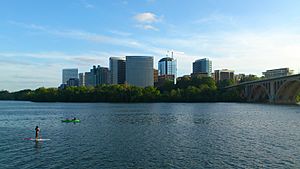
Former Virginia Governor Bob McDonnell described Northern Virginia as "the economic engine of the state" during a January 2010 Northern Virginia Technology Council address.
As of 2007[update] the Northern Virginia office submarkets contain 172,000,000 sq ft (16,000,000 m2) of office space, 33 percent more than those in Washington, D.C., and 55 percent more than those in its Maryland suburbs. 8,000,000 sq ft (740,000 m2) of office space is under construction in Northern Virginia. 60 percent of the construction is occurring in the Dulles Corridor submarket.
As of September 2008, the unemployment rate in Northern Virginia was 3.2 percent, about half the national average, and the lowest of any metropolitan area. While the U.S. as a whole had negative job growth between September 2007 to September 2008, Northern Virginia gained 12,800 jobs, representing half of Virginia's new jobs. As of July 2010, the unemployment rate of the region was 5.2 percent.
In the mid-2000s, Fairfax County was one of few places in the nation that attracted more creative-class workers than it created.
Internet
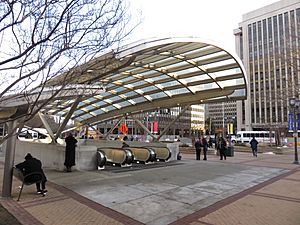
Northern Virginia is the busiest Internet intersection in the nation, with up to 70 percent of all Internet traffic flowing through Loudoun County data centers every day. It is the largest data center market in the world by capacity, with nearly double that of London, and the world's fastest-growing data market as of 2018. Loudoun County expects to have 6,500,000 sq ft (600,000 m2) of data center space by 2021. By 2012, Dominion Energy expects that 10 percent of all electricity it sends to Northern Virginia will be used by the region's data centers alone. Accenture estimates that 70 percent of Amazon Elastic Compute Cloud servers are located in their Northern Virginia zone. A 2015–16 estimate by Greenpeace puts Amazon's current and upcoming power capacity in Northern Virginia at over 1 gigawatt.
Notable companies

| Company | Industry | Headquarters | National rank |
|---|---|---|---|
| AES Corporation | Utilities: Gas and Electric | Arlington County, Virginia | 313 |
| Beacon Building Products | Wholesalers: Diversified | Herndon, Virginia | 420 |
| Boeing | Aerospace and Defense | Arlington County, Virginia | 58 |
| Booz Allen Hamilton | Information Technology Services | McLean, Virginia | 391 |
| CACI International | Information Technology Services | Arlington County, Virginia | 473 |
| Capital One Financial | Commercial Banks | McLean, Virginia | 99 |
| DXC Technology | Information Technology Services | Tysons, Virginia | 152 |
| Freddie Mac | Diversified Financials | McLean, Virginia | 47 |
| General Dynamics | Aerospace and Defense | Reston, Virginia | 84 |
| Hilton Hotels Corporation | Hospitality | McLean, Virginia | 324 |
| Leidos | Information Technology Services | Reston, Virginia | 248 |
| Northrop Grumman | Aerospace and Defense | Falls Church, Virginia | 86 |
| NVR, Inc. | Homebuilders | Reston, Virginia | 383 |
| Science Applications | Information Technology Services | Reston, Virginia | 412 |
| Company | Industry | Headquarters | National rank |
|---|---|---|---|
| Bechtel | Construction | Reston, Virginia | 15 |
| Carahsoft | Information Technology Services | Reston, Virginia | 44 |
| Mars | Food and Drink | McLean, Virginia | 4 |
Verisign, the manager of the .com and .net top-level domains, is based in the region. Major companies formerly headquartered in the region include AOL, Mobil, Nextel/Sprint, PSINet, Sallie Mae, MCI Communications, Transurban, and UUNET.
Attractions
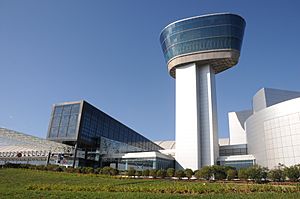
The region's large shopping malls, such as Potomac Mills and Tysons Corner Center, attract many visitors, as do the region's Civil War battlefields, which include the sites of both the First and Second Battle of Bull Run in Manassas and the Battle of Fredericksburg in Fredericksburg. Old Town Alexandria is known for its historic churches, townhouses, restaurants, gift shops, artist studios, and cruise boats.
The waterfront and outdoor recreational amenities such as biking and running trails, including the Washington and Old Dominion Rail Trail that leads from Alexandria to the foothills of the Blue Ridge, the Mount Vernon Trail and trails along various stream beds, whitewater and sea kayaking, and rock climbing areas along the Potomac River, various parks, Great Falls Park, and historic Mount Vernon, which opened a new visitor center in 2006. The Government Island park and quarry in Stafford County has views of the Potomac River. Aquia Creek was the source for many of the building materials for the White House, and U.S. Capitol. Also in Stafford County are historic places, including George Washington's boyhood home, Ferry Farm,, the Civil War headquarters and plantation Chatham Manor, and Gari Melchers Home & Studio.
Arlington National Cemetery and the Steven F. Udvar-Hazy Center, an annex of the National Air and Space Museum, which includes exhibits that cannot be housed at the main museum in Washington, D.C., due to space constraints. Concerts and other live shows are held at the Wolf Trap National Park for the Performing Arts in Wolf Trap.
Culture

Due to the proximity to the capital, many Northern Virginians go to Washington, D.C., for cultural outings and nightlife. The Kennedy Center in Washington, D.C., is a popular place for performances, as is Wolf Trap National Park for the Performing Arts near Vienna. Jiffy Lube Live (near Manassas), EagleBank Arena at George Mason University in Fairfax, and Capital One Arena in Washington serve as popular concert venues, and Capital One Arena also serves as the home of sporting events. Smithsonian museums also serve as local cultural institutions with easy proximity to Northern Virginia, and the Udvar-Hazy Center of the National Air and Space Museum in Chantilly is popular as well.

Tysons Corner Center ("Tysons I") is one of the largest malls in the country and is a hub for shopping in the area. Tysons Galleria ("Tysons II"), its counterpart across Route 123, carries more high-end stores. Tysons itself is the 12th-largest business district in the United States. Other malls include Springfield Mall, Fair Oaks Mall, Manassas Mall, Spotsylvania Towne Centre which has a mall and a mixed-use retail and commercial area, and The Fashion Centre at Pentagon City. Dulles Town Center is the region's newest mall, serving the eastern Loudoun County area. Reston Town Center is a high-density mixed-use retail, commercial, and residential development located just off the 267 Toll Road in Reston. Potomac Mills, located in Prince William County, is the largest outlet mall in the region. The town of Leesburg in Loudoun County contains the Leesburg Corner Premium Outlets outlet mall.
Recreation
Northern Virginia is home to many activities for families and individuals, including biking/walking trails, sports leagues, recreation facilities, museums, historic homes, and parks.
It is home to the Northern Virginia Swim League, which comprises 102 community pools, and NVSL-Dive, which is composed of 47 teams in Fairfax and Arlington counties. The swim and dive teams compete over the course of 5–6 weeks from the end of June through the first weekend in August.
The National Capital Area Council operates in the Washington metropolitan area. It serves localities in the Washington D.C Metropolitan Area. In Northern Virginia, it has chapters and divisions that serve, Fairfax County, Loudoun County, Prince William County, Stafford County, Arlington County, the City of Alexandria, and the City of Fairfax. It also serves Caroline County, the City of Fredericksburg, and Spotsylvania County.
The National Capital Soccer League serves soccer leagues and associations in the Washington D.C Metropolitan Area. It includes Northern Virginia soccer associations in Fairfax County, Loudoun County, Prince William County, Stafford County, Arlington County, the City of Fredericksburg, the City of Alexandria, the City of Fairfax, and one soccer association in Culpeper County, Winchester, and Warrenton.
Secession
Former Republican delegate Jeannemarie Devolites Davis expressed a common sentiment when she said "The formula for funding school construction in Northern Virginia requires that we pay 500 percent more than the actual cost of a project. We have to pay 500 percent because we give 400 percent away to the rest of the state." The state government's funding level for transportation projects in Northern Virginia is a perennial issue that often causes consternation from the region's politicians and citizens.
Many people consider the idea of secession a rhetorical one used to express frustration with the treatment of Northern Virginia by the state government as well as the opposing political sentiments between it and the rest of Virginia. Critics often point out that all states include regions of varying income and political discrepancies within their borders. Nevertheless, the Northern Virginia suburbs of Washington, D.C., are often seen as an extension of the more urbanized Mid-Atlantic, north-east, and the Boston-Washington corridor, even though Virginia as a whole is considered a Southern state. This perception is especially fueled by the region's closeness to Washington, D.C., large numbers of Northern transplants, and the prevalence of both new immigrant communities and growing ethnic diversity. Nevertheless, there is no serious secessionist movement.
Transportation
Airports

The area has two major airports, Ronald Reagan Washington National Airport in Crystal City, the nation's 23rd-busiest airport by passenger traffic as of 2022 and the busiest airport in the Washington metropolitan area, and Dulles International Airport in Dulles. in both passenger loadings and aircraft movements, and the 16th-busiest airport in the nation by takeoffs and landings in 2007. Dulles is the region's primary international gateway, serves as a hub for United Airlines, and has recently improved its low-cost carrier offerings with the addition of multiple flights by Southwest and JetBlue.
Subway and passenger trains
Commuters are served by the Washington Metro subway and the Virginia Railway Express (VRE), a commuter railroad. Metro is the second-busiest subway system in the nation after the New York City Subway system. A completed expansion project extends the system past Dulles International Airport into Loudon County. The VRE has two lines adjacent to I-66 and I-95 starting in Union Station and extending to Manassas and Spotsylvania, respectively. VRE service is significantly more limited, but nevertheless saw over a year of continuous ridership increase from 2007 into 2008. Bus service is provided by WMATA's Metrobus and several local jurisdictions.
Highways
The Washington metropolitan area has the worst traffic in the nation, and Northern Virginia is home to six of the ten worst bottlenecks in the area. To alleviate gridlock, local governments encourage using Metrorail, HOV, carpooling, slugging, and other forms of mass transportation. Major limited- or partially limited-access highways include Interstates 495 (the Capital Beltway), 95, 395, and 66, the Fairfax County Parkway and adjoining Franconia–Springfield Parkway, the George Washington Memorial Parkway, and the Dulles Toll Road. High-occupancy vehicle (HOV) lanes are used for commuters and buses on I-66, I-95/395, and the Dulles Toll Road. A study done by INRIX Roadway Analytics ranked Southbound I-95 from Washington D.C to the southern tip of Stafford County the worst single traffic hotspot in the nation. It also ranked Northbound I-95 from Spotsylvania County to the northern tip of Stafford County the seventh worst traffic hotspot in the nation. Northern Virginia is also home to the Express Lanes. These express lanes are where a car has an E-ZPass transponder and is charged for riding a distance on the express lanes. They are currently being built on I-66, and are currently available on I-395, I-495 from the Springfield Interchange to Tysons Corner but are being extended to the Maryland-Virginia border, and I-95 from the end of I-395 (Springfield Interchange) to central Stafford County and are being extended to Fredericksburg.
Two major regional bottlenecks, the Springfield Interchange and Woodrow Wilson Bridge, were massively reconstructed with completion in 2007 and 2008. Generally, Potomac River crossings remain major choke points; proposals to add crossings (such as near Leesburg or Quantico as part of a long-proposed Outer Beltway) are opposed by Virginia communities near the suggested bridge sites, and by Marylanders who fear that new bridges would bring new housing development to green space in that state such as Poolesville. Because of Northern Virginia's high housing costs, tens of thousands of employees there choose more affordable housing far away in outer Virginia exurban counties, or in Prince George's County and Southern Maryland, thus creating tremendous traffic congestion on the Potomac bridges. This situation is much like metropolitan areas of California. Furthermore, Fairfax County localities such as Great Falls, Dranesville, and Clifton impose low-density, large-acreage residential zoning, which forces developers to leapfrog into Loudoun and Prince William counties to build housing, thus increasing commuters' driving distances. In recent years, developers have continued to develop in Loudoun County, but have filled Prince William County, leading many developers to move south to Stafford County, where local government has been more receptive to developments.
Education
Primary education
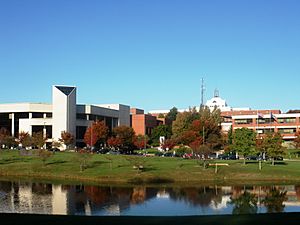
Fairfax County's public school system includes the Thomas Jefferson High School for Science and Technology, an award-winning magnet school. As of 2021, 19 of the region's schools appear in the top 200 of Newsweek's "America's Top Public High Schools", and Thomas Jefferson is ranked number one. In comparison, Washington, D.C., Maryland, and the rest of Virginia have 10 schools between them in the top 200.
Colleges and universities
George Mason University, in Fairfax, is the largest public university in Virginia.
Other higher education institutions include Northern Virginia Community College (colloquially known as NOVA) in Annandale (with several branch campuses throughout Northern Virginia), the University of Mary Washington in Fredericksburg, Patrick Henry College in western Loudoun County, and Marymount University in north Arlington. The University of Virginia and Virginia Tech maintain a Center in Falls Church, and George Washington University has a campus in Loudon County. Virginia Commonwealth University Health Systems has a satellite campus in Fairfax at the Inova Health System.







